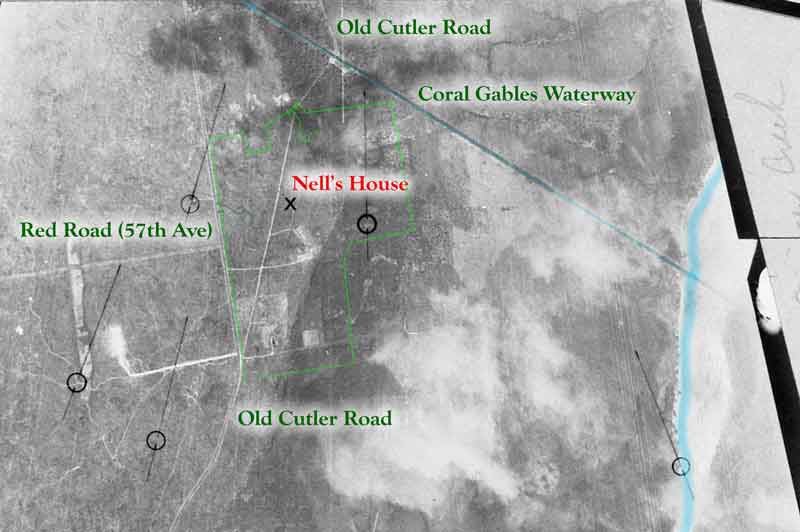Montgomery Botanical Center is the living legacy of Robert and Nell Montgomery, widely known as the founders of Fairchild Tropical Garden. Housed on their 120-acre Coral Gables estate, it included the largest and finest private collections of palms and cycads in the world.
Colonel Robert H. Montgomery was one of the founding partners of the accounting firm, Lybrand, Ross Bros. & Montgomery—known today as Pricewaterhouse Coopers. He wrote more than 40 books about accounting practice and tax law. In addition to being a lawyer, accountant, and book collector, Colonel Montgomery was a lover of plants. In 1936, he founded Fairchild Tropical Garden, just 1 mile north in Coral Gables. He and his wife, Nell, donated the 83-acre tract of land as well as money for developing the plant collections. On May 2, 1953, while napping in his Florida home, 80-year-old Robert Montgomery died. He and Nell had just completed their daily stroll through the Coconut Grove Palmetum.
Upon Robert’s death in 1953, his wife, Eleanor “Nell,” inherited the Coconut Grove Palmetum. Nell wanted to perpetuate her late husband’s name in association with the plant collections and the estate. She also desired to provide a site for research investigations on the collections. With these goals in mind, she created The Montgomery Foundation, Inc., on November 20, 1959, as a private, non-profit, operating institution devoted to advancing the science of tropical botany by building research-oriented plant collections. In 1998, the name was changed to the Montgomery Botanical Center.
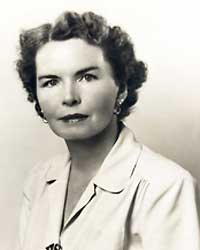
Eleanor “Nell” Montgomery
For over 30 years, Nell committed her life to the development and growth of MBC and FTG. Upon her death on June 4, 1990, she left the balance of her estate and an endowment to maintain the property to MBC.
Since Nell’s death in 1990, MBC directors and staff have worked to secure and promote Nell’s vision. As part of the transition, a long-term Master Site Plan was developed in 1992 by the internationally recognized firm of Sasaki Associates, Inc. This Plan, which is strategically divided into five phases, was designed so that expansion of the plant collections could proceed in a systematic and aesthetically pleasing way. According to the Plan, the 120-acre property is delineated into four geographic areas: the Coconut Grove Palmetum, the South Palmetum, the Lowland Palmetum, and Research. The Research area contains research laboratories, the Montgomery Library, a herbarium, the offices of the American Orchid Society, and nursery facilities operated by Fairchild Tropical Botanic Garden on eight acres leased by the Center to the Garden.
An overview of the history of Robert and Nell Montgomery in Florida, as well as the property from 1932 to 1997, was superbly documented in The Montgomery Story by Bert Zuckerman. This 1997 volume is available for purchase from MBC.
This 1928 aerial photograph shows the Montgomery home, and the original route of Old Cutler Road as it cuts through the area that is now the Montgomery Botanical Center.
There are various stories of why Colonel Robert Montgomery came to South Florida and started a palm collection. The most accepted story is that the Colonel was involved in a friendly competition of collecting conifers in Connecticut with his friend George Brett, owner of Macmillan Press. George, who was growing palms at his Coconut Grove estate, challenged the Colonel to come to South Florida and continue their friendly competition, but with palms and cycads. So the Colonel accepted the challenge. He hoped to establish the largest and most complete collection of rare palms (and other tropical plants) in Florida.
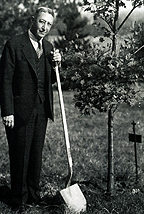
Col. Robert Montgomery was a lover of plants, pictured here at his pinetum in Cos Cobb, Connecticut where he had over 700 species. At the urging of his friend George Brett, the Colonel expanded his interests to collecting palms and cycads at his palmetum in Florida.
Creation of the Coconut Grove Palmetum – 1932
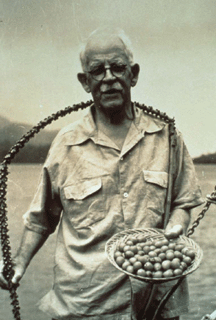
Dr. David Fairchild
With the help of Dr. David Fairchild, the Colonel traveled around Florida in the summer of 1932 buying large specimen palms from nurseries, growers, and private collectors. He bought specimens of every palm species known to be growing in Florida at that time, about 150 species in all. Tom Fennell, of the U.S. Department of Agriculture Plant Introduction Station at Chapman Field, was also very instrumental in the development of the palmetum. In 1932, the Colonel successfully transplanted about 700 specimen palms to the estate and named it the Coconut Grove Palmetum. Dr. David Fairchild, a celebrated plant explorer, was instrumental in helping Col. Robert Montgomery build his collection of palms.
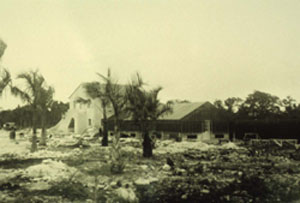
Gatehouse and Greenhouse in 1932
The planting of the Palmetum began in 1932. On the right, with their showy crownshafts, are royal palms (Roystonea regia) that were planted along the main driveway. In the foreground is a young Hyphorbe vershaffeltii or spindle palm.
By the end of 1933, ten acres had been cleared and 237 species and varieties of palms—totaling over 1,000 mature specimens—had been planted in the Palmetum. Col. Montgomery spent a total of $80,000 on plants, grading, landscaping, and planting during those first two years. This paled in comparison to the $10,000 he spent for the property and the $22,000 he spent to build his house.
Growth of the Coconut Grove Palmetum – 1933 to 1990

The Montgomery Home in 1936
Through his friend Dr. David Fairchild, the Colonel made many contacts throughout the world from whom he received seed. The Colonel continued to work aggressively to cultivate even more contacts and thus obtained plants from practically every portion of the tropics, receiving over 900 lots of seed from over 200 foreign sources during a two-year period. The palms grown from those seed represented approximately 155 species, bringing the total number of species of palms in the Palmetum to 306. By 1939, in his book Fifty Years of Accounting, Montgomery reported having over 400 species of palms and cycads growing in the ground. In truth, by December 1939, the Colonel’s inventory showed a total of 432 palm species, 50 cycad species, and 1,051 other species. In summary, Montgomery purchased plants and/or seeds from at least 64 nurseries and individuals, and acquired others from the USDA, numerous botanical gardens, universities, foreign sites, and expeditions worldwide to aggressively build one of the largest private palm collections in the United States. By 1933, the Coconut Grove Palmetum had over 1000 mature palm specimens and by the early 1940s it had become one of the largest private collections of living palms in the U.S. This aerial photograph was taken in 1936.
Some of the collectors who contributed many plants to the palm collection, after 1953 and before Nell passed away were:
Dr. Fred Boutin – Belize and Mexico
Paul Chai – Malaysia
Nancy Hammer – Costa Rica and the United States
Dr. Fred Essig – Ecuador
Dr. Jack Fisher – Malaysia
Ken Foster – Jamaica, Honduras, Papua New Guinea, New Caledonia, and Fiji
Donald Hodel – New Caledonia, Fiji, Hawaii, and Guatemala
DeArmand Hull – Costa Rica, Panama, Peru, Papua New Guinea, and Venezuela
Stanley Kiem – Cuba and the West Indies, Guatemala, Brazil, Tanzania, and Malaysia
Arthur C. Langlois – Madagascar
Dr. Harold E. Moore – Malaysia, Australia, Comoros, Vanuatu, Costa Rica, and Mexico
Dr. Richard Moyroud – USA
Dr. Robert Read – Hispaniola and Jamaica
Dr. P. B. Tomlinson – Trinidad and Tobago, and Malaysia
Nina Woessner – Costa Rica
After Nell Montgomery’s death in 1990, The Montgomery Foundation became active and began rebuilding the collections with wild-collected, scientifically-documented material.
In 1992, The Montgomery Foundation supported its first expeditions. The first expedition was to Brazil and was organized and conducted by Dr. Larry Noblick. Later in 1992, Dr. Terrence Walters conducted an expedition to China.
Rebuilding and Expanding the Collections – 1992 forward
1992 was not quite tabula rasa, but Hurricane Andrew set back every garden in Miami. Montgomery has weathered many such hurricanes since 1932, and every time, we recovered and moved forward. Montgomery’s Master Plan was also developed that year—the hurricane strongly motivating that new vision. More information on Hurricanes and recovery can be found on our Disasters page.
Hurricane Andrew spurred increased interest in Expeditions for Montgomery Botanical Center, in part to replace collection specimens lost to the tempest. It also presented new opportunities in research, as the naturally felled specimens (that would not otherwise be sacrificed for study) could be anatomically studied in ways that could not be done on living specimens. “Stem Structure of the Cuban Belly Palm” by Fischer, Burch, and Noblick appeared in a 1996 issue of Principes (40.3, pp. 125-128).
A New Era: 1992-2001
In 1998, the Foundation voted to change its name to Montgomery Botanical Center (MBC). MBC’s focus on building high-quality collections for scientific research continued.
There were 41 expeditions from 1992 through 2001. All were supported by MBC.
Those expeditions have directly resulted in the collection of over 370 palm taxa and have added over 2,500 palm specimens to the property. As Montgomery Botanical Center became better known, seed and plant donations to the collection increased, adding another 250 palm plants. The years since 1992 represent one of the most intensive growth periods for the collection since the 1930s. Some people who participated in the planning and mounting of these palm and cycad collecting expeditions include:
Russell Adams
James Cornett
Hazel Cropper
Dr. John Donaldson
Dr. John Dowe
Nancy Edmondson
George Eiton
Don Evans
Bernard Fisher
Dr. William Hahn
Blas Hermaez
Dr. John Janovec
Rolf Kyburz
Tom Milledge
Victor Miller
Dr. Larry Noblick
Santiago Orts
Joe Perner
Dr. George Proctor
Wilson Quizhpe
Dennis Stevenson
Suroojnauth Tiwari
Dr. Terrence Walters
Loran Whitelock
Joko Witono
Dr. Si-lin Yang
Dr. Elsa Zardini
Those expeditions have directly resulted in the collection of over 370 palm taxa and have added over 2,500 palm specimens to the property. As Montgomery Botanical Center became better known, seed and plant donations to the collection increased, adding another 250 palm plants. Years 1992 through 2001 represent one of the most intensive growth periods for the collection since the 1930s.
More recent years have seen a great expansion of Montgomery’s field research activities, taking its scientists and collaborators to distant corners of the globe in search of plants. This rich recent history of botanical field research can be reviewed on our Fieldwork page. In 2018, a generous gift from Dr. Lin Lougheed created the Plant Exploration Fund, allowing Montgomery to set its horizons even further afield!
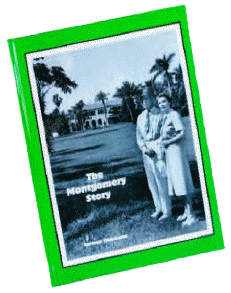
The Montgomery Story
Written by historian Bertram Zuckerman, The Montgomery Story chronicles the legacy Robert H. Montgomery and Nell Foster Montgomery Jennings left to South Florida. It recounts their backgrounds, the early years in Dade County as Colonel Montgomery built his Coconut Grove Palmetum estate, the development of Fairchild Tropical Garden, and the launching of The Montgomery Foundation, Nell’s memorial to her late husband that was to become Montgomery Botanical Center.
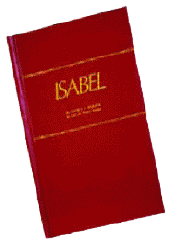
Isabel
Gun toting, mineral prospecting—and still a lady—Isabel Foster, mother of Nell Montgomery Jennings, led an adventure-filled life with her husband, Mac. Her story, as told to writer and friend Nixon Smiley, is a humor-filled and sometimes poignant narrative set in the rough and tumble Southern states of Tennessee, North Carolina, and Florida during the early decades of the 20th century.
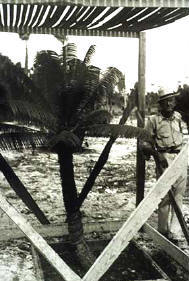
Planting Microcycas, 1932
Colonel Robert Montgomery’s fascination with cycads most likely started because of his love of conifers (he had an extensive private conifer collection in Connecticut) and the similar overall appearance between palms and cycads. In October 1932, Robert purchased and planted two Microcycas calocoma plants (RM384), one five feet and the other eight feet in height. The two plants cost him $90. By November of 1932, Robert had planted large specimens of three other species, Cycas rumphii (RM306), Cycas revoluta (RM311), and Dioon edule (RM323). By July of 1936, Robert had obtained and planted large specimens of Macrozamia moorei (RM974), Dioon spinulosum (RM910), Cycas media (RM976), Encephalartos altensteinii (RM1340), Encephalartos lehmanii (RM1341), and Encephalartos longifolius (RM1433), as well as more Microcycas plants (RM805) probably obtained from Brother Leon in Cuba. Robert’s estate superintendent (Adolph Jordahn, wrote Robert in Connecticut about the planting of the Macrozamia moorei plant and said that it took three men to carry this plant and he had been told that the plant was at least 1,500 years old. The plants of Dioon spinulosum were originally obtained from Veracruz, Mexico and the plants of Cycas media came, supposedly, from Rockhampton, Australia. Robert Montgomery continued developing his cycad collection at the Coconut Grove Palmetum until his death in 1953. Through the 1960s, 1970s, and 1980s, the cycad collection on the property continued to expand slowly.
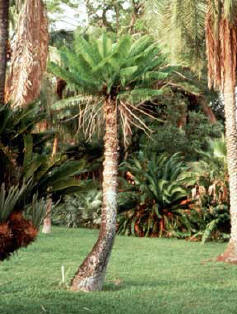
The 1932 Microcycas calocoma (RM384) in 1993.
Today, the purpose of the Montgomery Botanical Center’s cycad collection is to offer the research, conservation, and educational communities scientifically useful population-based samples of cycads. With that in mind, the Montgomery Botanical Center’s main focus is to develop its collections with as many wild-collected, documented population samples as possible. Montgomery Botanical Center’s cycad collection will, therefore, differ from most botanical gardens, since the emphasis is on maximizing the geographic, morphologic and genetic diversity among populations within a species, and not solely focused on number of species.
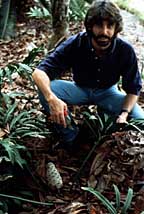
Former Executive Director, Dr. Terrence Walters, with the Stangeria collection
Montgomery Botanical Center’s first sponsored cycad expedition was to southern China in 1992. Since then, Montgomery Botanical Center has fielded an average of two expeditions each year to continue the development of the population-based cycad collection. In 2001, Montgomery completed expeditions to Belize, Ecuador, Mexico, and Panama to support the expansion of its New World cycad collection. A wonderful article by Virginia Hayes and Jeff Chemnick on the Mexico 2001 Expedition can be found in Volume 10, Number 2 of the Lotusland Newsletter.
Data from new collections are continually being recorded in Montgomery’s plant database. Montgomery documents its collections from the time seed is collected from a plant in the wild and throughout its life. A phenological examination (e.g., flushing, coning, health, etc.) of the collection is completed regulary. Digital images are obtained regularly to document growth and development. Male and female cone development is also electronically documented. Those data and images are made available to visiting scientists and educators accessing Montgomery’s collections for studies.
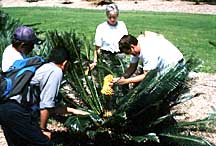
Montgomery’s Former Seedbank Coordinator, Judy Kay, and volunteer Larry Kraus, collecting the first male cone from a plant of Cycas panzhihuaensis. these plants were collected during the 1992 China expedition.
At the end of 2004, Montgomery’s cycad collection, including both the nursery and the ground collections, contained all 11 genera, 1,033 accessions, and over 4,400 seeds, seedlings, and plants in the Montgomery Botanical Center Nursery. Montgomery has over 2,750 cycads planted on the ground collection. The majority of the cycad collection is wild collected, grown from seed, and thoroughly documented, which makes Montgomery’s cycad collection one of the largest and most scientifically useful collections in the world. If you are interested in undertaking a research or study project on the cycad collection at Montgomery Botanical Center, please contact Michael Calonje. To encourage the scientific use of the collection, Montgomery offers guest housing to scientists and educators, 24-hour access to the plants, and security for long-term, on-site studies for projects associated with the collection.
In 1992, the internationally recognized landscape architectural firm of Sasaki Associates, Inc., created a long-term Master Site Plan for MBC. The Plan defined long-term land use, access and circulation, and landscape structure. A major landscape project within the Master Site Plan was the upgrading and expansion of the “Cycad Walk,” which was originally conceived and developed in the 1970s as a small, east-to-west walking path lined with a few cycads.
The Montgomery Archive documents the lives of Robert and Nell Montgomery in Florida as well as the history of Montgomery Botanical Center since its founding in 1959.
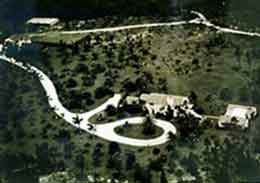
A 1936 aerial view of the Coconut Grove Palmetum. The large building in the foreground was the Montgomery home, which we now refer to as “Nell’s House.”
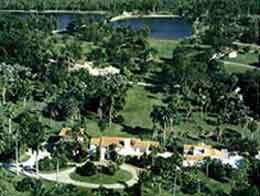
A 1994 aerial view of the same area shown in the photograph above. Nell’s House now contains the Montgomery Archive and the offices of Administration and Collections Development Departments for the Montgomery Botanical Center.
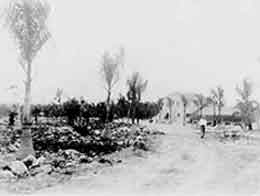
In 1932, Robert Montgomery began planning a Royal Palm Colonnade along the main driveway to his home. The Colonnade was the only formal landscape element in the landscape design for the property.

Robert and Nell Montgomery in 1939, enjoying the fruits from their palm collection (coconuts).

Robert Montgomery (on the right), Nell, and David Fairchild during the unveiling of the Spicer-Simpson designed Medallion Medal of Robert Montgomery in 1939. The Robert H. Montgomery Founders Medal is awarded to individuals based on distinguished achievement in the world of palms and cycads. Dr. Harold E. Moore Jr. was the first recipient of the medal.

The first to receive the Thomas Barbour Medal in 1948 was Colonel Robert Montgomery (second from the right). Later recipients of the Medal included: from left, H.M. Loomis, Wilson Popenoe, and to the far right, David Fairchild.
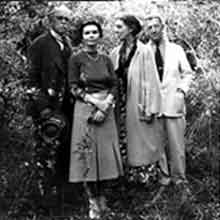 From left to right are David Fairchild, Nell Montgomery, Marion Fairchild, and Robert Montgomery in the Montgomery Botanical Center’s Lowland Palmetum in 1938.
From left to right are David Fairchild, Nell Montgomery, Marion Fairchild, and Robert Montgomery in the Montgomery Botanical Center’s Lowland Palmetum in 1938.

Nell Montgomery (1905-1990) and Robert Montgomery (1872-1953) standing in the main vista of the Coconut Grove Palmetum, Coral Gables, Florida, circa 1940s. This vista was designed by William Lyman Phillips. The Montgomery home (Nell’s House) is visible in the background.

Nell and Robert Montgomery on the patio of their home.
 The 1956 wedding reception of Nell and Alvin Jennings (far right). At that time, Alvin Jennings was a managing partner in Lybrand, Ross Bothers, & Montgomery. Nell’s parents, Isabel and Mac Foster are on the left.
The 1956 wedding reception of Nell and Alvin Jennings (far right). At that time, Alvin Jennings was a managing partner in Lybrand, Ross Bothers, & Montgomery. Nell’s parents, Isabel and Mac Foster are on the left.
 Dr. Arthur Montgomery (1909-1999) in the 1960s. Dr. Montgomery was the son of Robert and was one of the original five founders of the Montgomery Botanical Center. He served as Director and Vice President for the organization from its inception until 1999.
Dr. Arthur Montgomery (1909-1999) in the 1960s. Dr. Montgomery was the son of Robert and was one of the original five founders of the Montgomery Botanical Center. He served as Director and Vice President for the organization from its inception until 1999.
Dr. Montgomery, a well known mineralogist, was instrumental in creating and funding the Montgomery Research Fellowship Program and financed numerous research-associated positions for palm and cycad scientists.


